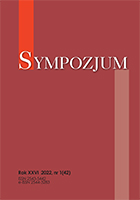Znaczenie instytucji Synodu Biskupów dla współczesnego Kościoła
Significance of Synod of Bishops for the present Church
Author(s): Tomasz RozkrutSubject(s): Christian Theology and Religion, History of Church(es), Theology and Religion, Canon Law / Church Law
Published by: Wyższe Seminarium Misyjne Księży Sercanów
Keywords: Bishop of Rome;episcopate;help;Second Vatican Council;Synod of Bishops;
Summary/Abstract: Institution of the Synod of Bishops was established by Pope Paul VI in his motu proprio Apostolica sollicitudo dated 15 September 1965. Successive legal image of the institution was defined by the Post-Conciliar Code of Canon Law of 1983, in can. 342-348. Also, in the years 1966, 1969, 1971, and 2006 there were published rules of the Synod of Bishops. Therefore, one may say that all Popes who ruled during councils, i.e. Paul VI, John Paul II, and Benedict XVI shaped the legal image and practical operation of the institution of the Synod of Bishops. One cannot also ignore a very important fact that on 15 September 2018 the present pope, Francis, published the Episcopalis communio apostolic constitution about the Synod of Bishops. Until now, there have been twenty-eight congregations of various meetings of the institution of the Synod of Bishops. However, the mentioned group should also be enlarged by so-called Dutch Synod. The institution of Synod of Bishops is a special and standing out institution in the Post-Conciliar Church. This is due to several elements, namely, not only the regular character of having meetings of the Synod of Bishops, but also the undertaken and analysed synodal problematic aspects that concerned various and important issues of life and functioning of the current Church. In this context, a special accent must be drawn to the indication of the theological and legal character of the institution that causes that we deal with a dynamic institution that shapes the life of the Post-Conciliar Church and by its structure encourages to have interest in the Synod of Bishops both on the doctrinal and factual level. Convening the Synod of Bishops is itself a major ecclesiastical event that engages not only the person of the Bishop of Rome, who is utterly responsible for its convention, but also the entire Church to a greater or lesser extent, and specifically the episcopate that is engaged in parallel in relation to the distincted stages of the Synod, i.e. its preparation, deliberations during the convened assembly, and the post-synodal stage that relates to fulfilment of synodal decisions. Considering this mainstream, one should also mention doctrinal messages of Synods of Bishops together with their propositions that directed the Magisterium of Bishops of Rome towards these areas that were considered a necessary aspect of their deliverance, essentially by publishing post-synodal apostolic exhortations which, in turn, very generally speaking had a successive influence on everyday life of the Church after the Second Vatican Council in many areas of the Church.
Journal: Sympozjum
- Issue Year: 42/2022
- Issue No: 1
- Page Range: 33-54
- Page Count: 22
- Language: Polish

